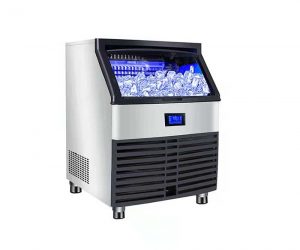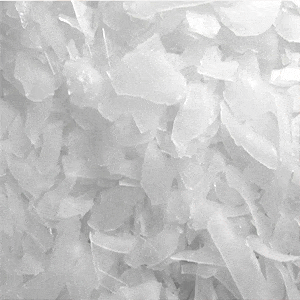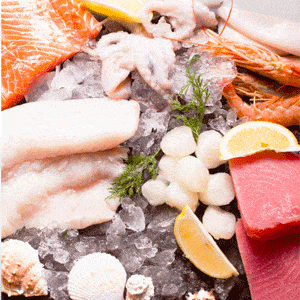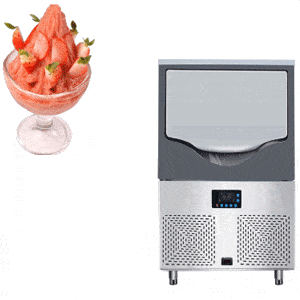What Type of Commercial Ice Makers Do I Need
Do you know the basics of a commercial ice maker? Follow Chefmax to understand the secrets of commercial ice machines. The sweltering heat looms over the globe, which means people are looking for ways to cool down. At this time, the demand for ice is soaring. Ice is an integral part of restaurant operations, whether it is used in restaurants, bars, cinemas or entertainment centers to serve your customers refreshments in the correct and fastest way. Equipping yourself with an commercial ice maker that gives you high-quality ice year-round is not only an option, it’s a must to keep your customers happy.
Table of Contents
1. What is commercial ice machine
A. How to define ice maker
An commercial ice maker is one of the most important pieces of equipment in a commercial kitchen that allows business owners to cater to their customers in the best possible way, so how do you define an ice maker? The ice maker is actually a kind of refrigeration machinery that cools the water through the evaporator by the refrigerant of the refrigeration system to generate ice. The refrigeration system is used to make ice after passing through a certain equipment under the power-on state with the water carrier. According to the original and production methods of the evaporator, the shape of the generated ice cubes is also different; people generally divide the commercial ice machine into particle ice machine, flake ice machine, plate ice machine, tube ice machine, shell ice machine, etc.

B. What are the components and functions of the commercial ice maker
Knowing the parts of the commercial ice machine will help you better maintain the equipment and manage the restaurant. The following are the parts involved in the ice machine and their introduction.
Compressor
The refrigeration compressor is the most important equipment in the refrigeration unit, and is usually referred to as the host in the refrigeration unit. The increase of the refrigerant vapor from low pressure to high pressure and the continuous flow and transportation of the vapor are all accomplished by the work of the refrigeration compressor, that is to say, the function of the refrigeration compressor is:
1. Absorb the refrigerant vapor from the evaporator to ensure a certain evaporation pressure in the evaporator.
2. Increase the pressure and compress the low-pressure and low-temperature refrigerant vapor into high-pressure and high-temperature superheated vapor, so as to create conditions for condensation at higher temperatures (such as the temperature of about 35°C in summer).
3. Transport and push the refrigerant to flow in the system to complete the refrigeration cycle.
Condenser
So the question is, how does a commercial ice maker achieve cooling through a condenser? It’s the condenser that cools the pressurized and hot gas and converts it back into a liquid state. The function of the condenser is to cool the high-pressure and high-temperature vapor (Freon vapor) delivered by the compressor into a high-pressure and high-temperature liquid high-temperature and high-pressure vapor state, and to cool it down, the refrigerant becomes a liquid, and then enters the expansion valve.
Expansion valve (throttle valve)
The expansion valve plays the role of throttling and depressurization. When the high-pressure refrigerant liquid condensed by the condenser passes through the throttling valve, part of the refrigerant liquid is vaporized due to the pressure drop due to obstruction, and at the same time, it absorbs the latent heat of vaporization, and its own temperature also increases. Correspondingly reduced, it becomes wet steam with low temperature and low pressure, and then enters the evaporator.
Evaporator
The evaporator is also a heat exchanger, which makes the low-pressure, low-temperature refrigerant liquid absorb the heat of the cooled medium (air, water, brine or other refrigerants) during the boiling process, so as to achieve the purpose of refrigeration.
2. The principle of commercial ice maker
The functioning of modern refrigeration systems is based on the second law of thermodynamics. In the simplest terms, the law states that heat can flow spontaneously from hot to cold objects, but heat does not spontaneously flow from cold to hot objects. Understanding how a commercial ice maker works is based on the application of this law and its use in reducing the temperature inside the refrigerator. During the entire cooling process, the cooling fluid or refrigerant fluid is converted from liquid to gas and then back to liquid. So, how do commercial ice makers work in these complex processes? affected by evaporation. Evaporation of the refrigerant causes the temperature to drop, causing the surrounding area to cool.
The specific steps are as follows:
Step 1: Compression process (inhale, exhaust, pressurize)
The low temperature and low pressure vapor refrigerant becomes high temperature and high pressure vapor refrigerant.
Step 2: Condensation process (condenser (liquefaction, heat dissipation)
The compressed high-temperature and high-pressure refrigeration vapor is cooled by air (or cooling water) in the condenser to release heat and condensed into liquid. As mentioned above, the premise of the refrigerant to produce the cooling effect is to change from liquid to gas, so condensation is very important.
Step 3: Expansion Process
After the refrigerant is liquefied, it is throttled and expanded to decompress and adjust the flow, and then enter the evaporator. Under the action of the expansion valve (capillary throttling), the condensed high-pressure liquid suddenly drops in pressure, and the liquid expands sharply, thereby transforming into a low-temperature and low-pressure mist and entering the evaporator.
Step 4: Evaporation Process
Here the refrigerant absorbs heat and evaporates, becoming a gas. After the expanded mist refrigerant enters the evaporator, it absorbs heat and gasifies, so that the surrounding temperature drops within the required low temperature range, so as to achieve the purpose of refrigeration.
The specific diagram can refer to the following figure:

Every component in a commercial ice maker ensures that the refrigeration cycle continues unimpeded. Since you now understand how commercial ice machines work, it’s important to use this information to maintain them the right way. Regular service inspections and maintenance are essential for your commercial ice maker to run seamlessly and serve you for a long time.
3. Type of commercial ice maker
According to the different principles of the evaporator and the generation process, the shape of the generated ice is also different. People generally divide the ice maker into a square ice machine, a crescent ice machine, a flake ice machine, and a snowflake machine according to the shape of the ice. When choosing the type of ice, its function is usually taken into account. The function of ice is mainly divided into three types: one is cooling, the other is edible, and the third is artificial scenes. Below are some common types of ice.
A. Square ice ice maker
This is the most typical beverage ice and the most widely used type of ice. If you are a business owner of a coffee shop, bar, or tea restaurant, from coffee, cocktails, whisky to juice, it is definitely your first choice!

B. Crescent Ice Ice Machine
Crescent Ice Ice Machine has the following features:
• The all-stainless steel ice tray is not easily affected by water quality, and it is difficult to accumulate impurities such as scale. It can keep the ice cubes clean and hygienic for a long time, and it is more durable and durable under the premise of ensuring the cooling effect, reducing the maintenance cost of the commercial ice machine.
• Flowing water double-sided ice making and ice removal, the ice tray is set vertically, the ice making water flows through the two sides of the ice tray and condenses into ice cubes, reducing energy loss, and a single output of ice is large, saving water and electricity.
• Stable performance, low failure rate, the whole machine adopts high-quality accessories. The main refrigeration accessories are all made of world-renowned brands, and various parameters are reasonably optimized. The crescent commercial ice machine is more efficient and energy-saving.
• The computer version controls the entire ice making process cycle to ensure the automatic operation and automatic detection of the machine. – Crescent moon ice is transparent and beautiful, not easy to stick, not easy to melt, small footprint, and small change in beverage taste.

C. Flake Ice Machine
Flake ice machines produce ice that is usually soft and chewy, and interestingly sized ice cubes are usually the ones you see in the market for seafood displays, to keep seafood fresh. Flake ice machines are also suitable for nursing homes and wound care centers.
Flake ice machine has the following features:
• Overall design, compact structure. ·Carbon steel freeze wall, hard chrome plated.
• Scientifically designed refrigerant circuit, unique copper tube welding technology, small refrigerant flow resistance, smooth cooling and large cooling capacity.
• Advanced double-wall ice-making evaporator, (exquisite design (welding) groove circulating refrigerant, double the heat exchange efficiency than traditional coil evaporator.·Fixed vertical cylindrical ice evaporator, through circular Move the ice scraper to collect ice and continue making ice.
• Universal controller adopts PLC and microcomputer control system. One-button start/stop of the machine with multiple safety features. ·Irregular flake ice, thin scaly ice, the size is about 40x40mm, and the thickness is between 1.5~2.5mm.
• Large contact area, good fluidity, large heat exchange surface area, faster and better cooling effect than other types of ice, and its flat shape will not damage fragile seafood products;

D. Scale ice maker
scales ice application features:
• Long-lasting effect of freezing and fresh-keeping;
• The ice cubes are thin and can be directly used for stirring and mixing the cooled object, and can also be evenly attached to the surface of the cooled object;
• The contact area is large and the cooling speed is fast, which can ensure that the temperature of each part of the cooled object is uniform;
• There is no sharp water chestnut, which will not damage the outer surface of the cooled object;
• Easy to crush, strong plasticity;
• Used in seafood, fish product preservation, perishable food transportation, food industry processing, bread making, poultry meat processing, cooked food, etc., medicine loading and unloading and concrete;
Application places: seafood market, supermarket, bakery, aquatic product processing industry, concrete mixing station, mine cooling, ski resort.

E. Snowflake Ice Maker
The name of the snowflake commercial ice maker is related to the shape of the ice it produces. The snowflake ice maker produces irregular tiny granular ice slag in the shape of snowflakes, which can quickly penetrate into small spaces and gaps and quickly. of cold. Snowflake ice machines are widely used in the food industry, such as pre-cooling in the processing of meat foods (ham, fish meatballs, dumplings, etc.), and pre-cooling in the processing of bread and cakes in dessert shops, etc. Ice maker. Snowflake ice making is also widely used in medical (hospital), chemical industry (laboratory, research institute) and food processing (supermarket food preservation) and other industries.
Snowflake Ice Maker application features:
• Stainless steel shell, beautiful, corrosion-resistant, easy to clean and durable.
• The cabinet is filled with fluorine-free foam insulation cover, which has good insulation effect. The inner pots are fluorine-free and sterilized, they are energy-saving and environmentally friendly. high-quality, high-efficiency and ecologically friendly fluorine-free compressors. The product quality is stable and the service life is long.
• Fully computer-controlled ice making, using imported computer chips, reliable control and easy operation.
• Ventilation holes and fans are provided to ensure reliable operation of the reducer motor in a high-temperature environment. -The evaporator is made of 304 stainless steel, and the ice-making is clean, clean and pollution-free.
• Widely used in hospitals, schools, laboratories, supermarkets, food preservation, fishery refrigeration, medical applications, and chemical and food processing industries. High efficiency, energy-saving, safety and environmental protection have quickly become the most popular choice for customers worldwide.

4. Summary
After reading the above content, I believe that you have a relatively in-depth understanding of the commercial ice maker definition, principle and type of commercial ice machine. If you want to know more professional knowledge, Contact [email protected] Now!
























